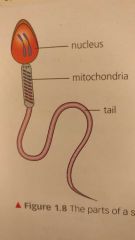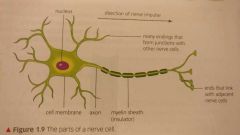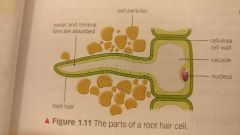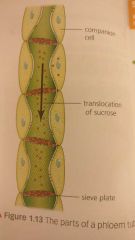![]()
![]()
![]()
Use LEFT and RIGHT arrow keys to navigate between flashcards;
Use UP and DOWN arrow keys to flip the card;
H to show hint;
A reads text to speech;
41 Cards in this Set
- Front
- Back
|
Biconcave |
Describes a shape with a dip that curves inwards on both sides |
|
|
Red Blood Cells |
Have a biconcave shape, to allow oxygen to be absorbed more quickly. They also have no nucleus, which means they can absorb more oxygen. |
|
|
What are 6 types of specialised cells? |
Sperm cell Nerve cell Muscle cell Root hair cell Xylem cell Phloem cell |
|
|
What does a sperm cell look like? |

|
|
|
Adaptations of sperm cells |
Have a tail - helps them swim towards the ovum Lots of mitochondria - energy to keep them swimming |
|
|
What must be done to control our actions? |
Signals must be sent and received |
|
|
Structure of a nerve cell |

|
|
|
Adaptations of nerve cells |
Myelin Sheath - insulates the electrical impulses Small extensions - pick up signals from neighbouring cells |
|
|
Axon |
The extension of a nerve cell along which electrical impulses travel |
|
|
Myelin Sheath |
The insulating cover along an axon, which speeds up the electrical impulse |
|
|
Three types of muscle cells |
Smooth muscle Cardiac Muscle Skeletal Muscle |
|
|
What can all three types of muscle in our bodies? |
Contract and relax |
|
|
Smooth Muscles |
Contracts and relaxes automatically. |
|
|
Where are smooth muscles found? |
Linings of the vessels that make up our circulatory system Iris of our eyes |
|
|
Cardiac muscles |
Contract and relaxes automatically |
|
|
Where are cardiac muscles found? |
In our heart |
|
|
Skeletal Muscles |
We control the contractions of these muscles so movements are not automatic |
|
|
Where are skeletal muscles found? |
Attached to our bones |
|
|
All three types of muscles are... |
Made from muscle cells. Require lots of mitochondria |
|
|
Structure of a Root Hair Cell |

|
|
|
Adaptations of Root Hair Cell |
Have a small thin extension which pokes out into the soil Increases surface area --> plants can absorb more water and minerals from the soil. |
|
|
Xylem Cells structure |

|
|
|
What do xylem cells carry? |
Water and some dissolved minerals from the roots upwards to other parts of the plants. |
|
|
Xylem |
Dead plant cells joined together into long tubes through which water flows during transpiration |
|
|
Transpiration |
The gradual release of water vapour from leaves to continue the pull of water up to them from the soil |
|
|
Where does xylem carry water? |
To the green parts of the plants for photosynthesis during the day. |
|
|
Do xylem cells have end walls? |
No they have no end walls, and no contents (hollow) |
|
|
What reinforces a xylem tubes side walls? |
Lignin |
|
|
Phloem |
Living cells that carry sugars made in photosynthesis to all cells of a plant. |
|
|
Translocation |
The movement of sugars made in photosynthesis from the leaves of plants |
|
|
What do phloem cells carry? |
Glucose (as sucrose) made in photosynthesis |
|
|
What is the sugar used for? |
Immediately in respiration Stored as starch in cells or structures such as the roots of vegetables. |
|
|
Structure of Phloem |

|
|
|
What are Sieves Plates |
Specialised end walls with small holes in them |
|
|
How are phloem and xylem cells arranged? |
In bundles together which make up the veins you see in a leaf. Xylem towards the leaf. Phloem away |
|
|
Cell differentiation |
Generalised cells become specialised as an organism develops |
|
|
When does cell differentiation occur? |
While you are in your mothers uterus |
|
|
Till when can plant cells differentiate? |
Throughout their life |
|
|
Embryonic Stem Cells |
Inner cell mass of blastocyst Can become any type of cell Some left on umbilical chord |
|
|
Pluripotent |
Embryonic stem cells Can become any cell |
|
|
Meristem/ Plant Stem Cells |
Found in plants Can differentiate at any time |

